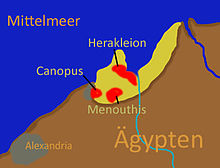Heracleion
This article needs additional citations for verification. (September 2016) |
 | |
| Location | near Alexandria, Egypt |
|---|---|
Heracleion (Template:Lang-gr), also known as Thonis (Θῶνις), was an ancient Egyptian city located near the Canopic Mouth of the Nile, about 32km northeast of Alexandria. Its ruins are located in Abu Qir Bay, currently 2.5 km off the coast, under 10 m (30 ft) of water.[1] Its legendary beginnings go back to as early as the 12th century BC, and it is mentioned by ancient Greek historians. Its importance grew particularly during the waning days of the Pharaohs. In the Late Period, it was Egypt's main port for international trade and collection of taxes.
Heracleion was originally built on some adjoining islands in the Nile Delta, and was intersected by canals. It had a number of harbors and anchorages and was the sister city of Naucratis until it was superseded by Alexandria.
Legendary beginnings

It was believed that Paris and Helen of Troy were stranded here on their flight from the jealous Menelaus, before the Trojan war began[citation needed] or that Menelaus and Helen had stayed there, accommodated by the noble Egyptian Thon[2] and Polydamna. Also, it was believed that Heracles himself had visited the city, and that the city had gained its name from him.
Ancient references
Until very recently the site had been known only from a few literary and epigraphic sources, one of which interestingly mentions the site as an emporion, just like Naukratis.
— British Museum, 2013[3]
The city was mentioned by the ancient historians Diodorus (1.19.4) and Strabo (17.1.16). Herodotus was told that Thonis was the warden of the Canopic mouth of the Nile: Thonis arrested Alexander (Paris), the son of Priam, because Alexander had abducted Helen of Troy and taken much wealth.[3][4]
Heracleion is also mentioned in the twin steles of the Decree of Nectanebo I (the first of which is known as the 'Stele of Naukratis'), which specify that one tenth of the taxes on imports passing through the town of Thonis/Herakleion were to be given to the sanctuary of Neith of Sais.[3] The city is also mentioned in the Decree of Canopus honoring Pharaoh Ptolemy III.
The city of Heracleion was also the site of the celebration of the ‘mysteries of Osiris' each year during the month of Khoiak. The god in his ceremonial boat was brought in procession from the temple of Amun in that city to his shrine in Canopus.[citation needed]
Archaeology

The city had a large temple of Khonsou, son of Amun, who was known to the Greeks as Herakles.[5] Later, the worship of Amun became more prominent.
Heracleion flourished especially from the 6th to the 4th century BC, as revealed by numerous archaeological finds. Pharaoh Nectanebo I made many additions to the temple in the 4th century B.C.[6] The city sank in the 3rd or 2nd century AD, probably due to liquefaction of the silts on which it was built following earth tremors.
The ruins submerged in the sea were located by the French underwater archaeologist Franck Goddio in 2000.[7] Until then, the scholars were not sure if Heracleion and Thonis were in fact one and the same city.
See also
References
- ^ "Heracleion Photos: Lost Egyptian City Revealed After 1,200 Years Under Sea". The Huffington Post. 29 April 2013.
- ^ Stephanus of Byzantium. "Θῶνις". Ethnika kat' epitomen (in Greek).
- ^ a b c Naukratis: a city and trading port in Egypt, British Museum
- ^ Herodotus, Histories, 2.113-115
- ^ Anne Burton, Diodorus Siculus, Book 1: A Commentary. BRILL, 1972 ISBN 9004035141 p105
- ^ "Lost city of Heracleion gives up its secrets". The Telegraph. Retrieved 2013-06-06.
- ^ Sooke, Alastair. "Sunken Cities: the man who found Atlantis". The Telegraph. Retrieved 22 September 2016.
External links
- "Spectacular finds of lost city revealed". News. BBC. 7 June 2001. Retrieved 2013-06-06.
- "Searching for Sunken Cities". Ancient Egypt Magazine. Jul–Aug 2000.
- "Sunken Egyptian city reveals 1,200-year-old secrets". Yahoo!. Retrieved 2013-06-06.
- Photos of underwater treasures of Heracleion (French text)

